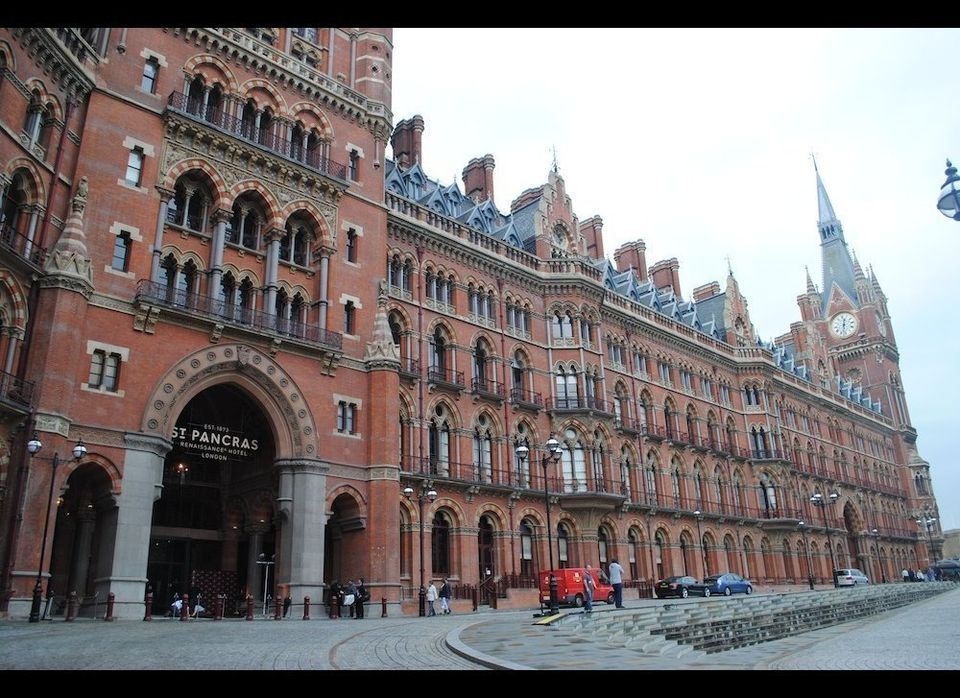If you listen closely, you can still hear the swooshing of the wide Victorian dresses on women as they walked down the hallways of the St. Pancras Hotel in the 1800s. Built to accommodate the glamor of the time, the unusually wide hallways at the St. Pancras are adorned with dimly-lit chandeliers and red and gold accents. The suites connect on the first floor of the Chamber's Quarters so guests could have a parlor room, dressing room and bedroom. As the trains rumble into the station below the hotel, you half expect to see men in dress coats and top hats step off the platform, their leather luggage properly in tow, heading into the hotel for a glass of scotch as the night's party slowly begins. The events at St. Pancras were never less than grandiose, and the re-opening party of this grand hotel kept to the same style. (*SEE PHOTOS BELOW*)
Originally built in the late 1800s, the St. Pancras train station soon became a staple among London's elite. Not only did it connect East Midlands and Yorkshire with London, but it included a hotel designed by George GIlbert Scott - an architect commissioned from Victoria to create the memorial in Hyde Park to Prince Albert - that wrapped gothic attitude around English civility. The station started operating in 1868 and by 1873, the Midland Grand hotel (built as part of the station) welcomed its first guests. The rooms featured 18-foot ceilings, neoclassical murals and marble floors. The wallpaper was created specifically for the hotel -- an ornate red and gold fleur dy lys pattern -- and the accessories (everything from mirrors to pillows) were handpicked for each room.
The new majestic hotel was a divine addition to the classic architecture that lined the city streets. The St. Pancras station and hotel introduced London to a new way of travel and living. Not only was it the first time trains connected in the north side of London, but the hotel was the first to introduce the Ladies' Smoking Room -- the first public room in Europe where women were allowed to smoke, acknowledging the status (and often, wealth) of women. The grand staircase, which even today stands as St. Pancras' main focal point, was a masterpiece that even Scott himself was in awe over, once saying the hotel and its design was "almost too good to be true." It boasted the first ever flushable toilets in London, a the first button for bellman service, and a fireproof floor construction. London's elite vied rooms at the Midland Grand, but by the 1920s the Midland Grand was losing its luster. Hotels were being built around London that rivaled the Midland Grand's then-futuristic initiatives, and the hotel itself was in desperate need of a renovation. In 1935, the hotel closed, ending a pivotal chapter in London's progressive turn-of-the-century hospitality history.
The station continued to operate without its hotel, which was officially abandoned in 1985 and remained that way for nearly 20 years, opening its doors randomly when Hollywood called for included "Batman," "Bridget Jones' Diary," "Harry Potter and the Chamber of Secrets," (track 9 3/4 is one of the platforms of the train station), and a music video featuring then-famous girl group, the Spice Girls. In 2002, an effort to revitalize and reopen the hotel took place and nine years later, the St. Pancras Renaissance Hotel opened its doors.
Marriott took great care in preserving the unique designs originally bestowed inside the Midland Hotel. Today, guests still walk up the grand staircase, saunter down wider-than-normal hallways and rest inside ornate designed rooms complete with 18-foot ceilings and marble floors in the bathrooms. The new section of the hotel - built as part of the renovation - features a more modern design and decor, but still offers the same views of the old train station and ambiance of a bygone era filled with prosperity and hope.
Celebrating history and future, the train station and hotel entered a new chapter on May 5 when the St. Pancras Renaissance Hotel officially re-opened the doors to the new hotel. Complete with burlesque dancers, classic choirs, celebrity guests including Adrien Brody, Jarvis Cocker, George Lamb and Sophie Ellis Bextor, and a special musical performance by Jamie Cullum, the new hotel found a way to blend old and new in a classic and trendy style. Well underway to merging London's majestic history with its enterprising future, the St. Pancras Renaissance Hotel is the tale of a true renaissance -- one with all the glamor, mystery and elegance that it takes to make a true comeback.
